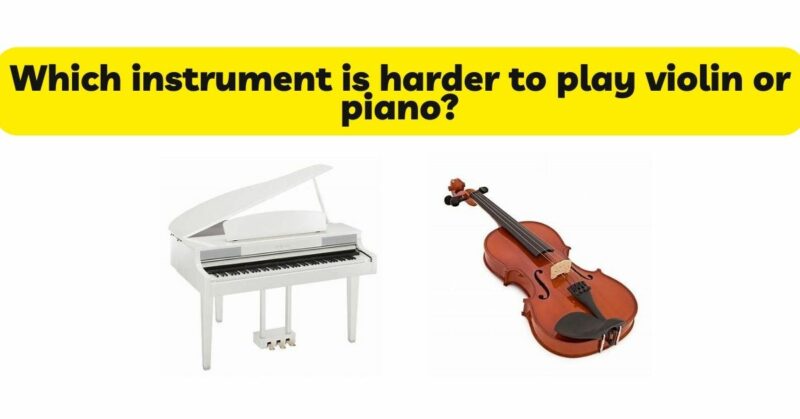The question of which instrument is harder to play, the violin or the piano, has long intrigued aspiring musicians and music enthusiasts. Both instruments require dedication, practice, and a deep understanding of musicality to master. In this article, we will delve into the complexities of playing the violin and the piano, examining factors such as technical demands, physicality, expressive capabilities, and learning approaches. By gaining a comprehensive understanding of the challenges associated with each instrument, we can appreciate their unique qualities and appreciate the artistry required to excel in both.
- Technical Demands and Complexity: When considering the technical demands and complexity, both the violin and the piano present distinct challenges. The violin requires precise finger placement, bow control, and a keen sense of intonation. Mastery of techniques such as shifting, vibrato, and bow articulation demand focused practice and a strong foundation in violin technique. Additionally, the violinist must develop a sophisticated ear for intonation, as the instrument lacks visual cues such as frets or keys. The piano, on the other hand, demands finger independence, hand coordination, and the ability to navigate complex musical arrangements. Pianists must develop techniques such as scales, arpeggios, and finger dexterity to execute intricate passages and expressively interpret music. Each instrument presents its own set of technical complexities, requiring dedicated effort and focused practice to overcome.
- Physicality and Instrumental Technique: The physicality of an instrument plays a significant role in shaping its level of difficulty. The violin demands a unique physical approach, as players must hold the instrument against the shoulder, chin, and collarbone while manipulating the bow with the right hand and placing the fingers accurately on the fingerboard. This physical positioning, along with the requirement for finger strength, flexibility, and dexterity, can pose challenges for beginners. Furthermore, the violinist must develop a relaxed bowing arm and hand position, as well as a solid left-hand technique to produce a resonant and controlled sound. In contrast, the piano’s physical demands lie primarily in the hand and finger movements required to navigate the keyboard. Proper hand position, finger strength, and finger independence are crucial for achieving technical proficiency. While the piano does not demand the same level of physical contortion as the violin, it requires developing a sensitive touch and refined control over the keys.
- Expressive Range and Interpretation: Both the violin and the piano offer vast opportunities for expressive range and musical interpretation. The violin is renowned for its ability to mimic the human voice, producing a wide array of tonal colors and nuanced phrasing. Techniques such as vibrato, bow articulation, and dynamic control enable violinists to convey emotions and tell musical stories through their playing. The piano, with its rich harmonic possibilities and dynamic capabilities, offers a different avenue for expression. Pianists can explore a wide range of tonal qualities, create complex textures, and employ various articulation techniques to shape their interpretations. The ability to convey emotions through both instruments requires a deep understanding of musicality, sensitivity, and the ability to communicate through sound.
- Learning Curve and Progression: The learning curve and progression associated with each instrument can influence perceptions of their difficulty. The violin has a steep learning curve due to its unique techniques, intricate finger placement, and bowing intricacies. Building a strong foundation in violin technique, developing a sensitive ear for intonation, and acquiring a sense of control over the bow requires consistent and focused practice. The absence of visual cues adds an additional layer of complexity, requiring the player to rely on kinesthetic and aural awareness. On the other hand, the piano offers a more gradual learning curve, particularly in the early stages. The visual layout of the keyboard and the ability to read music notation relatively easily make initial progress more accessible. However, mastering advanced piano techniques, sight-reading skills, and coordination between both hands demand dedicated practice and a deep understanding of musical concepts.
- Personal Preferences and Musical Goals: When evaluating the difficulty of an instrument, personal preferences and musical goals play a significant role. Some individuals may feel a natural affinity for the violin, drawn to its expressive capabilities and the rich classical tradition associated with the instrument. The challenges associated with the violin may be met with enthusiasm and dedication, aligning with their musical aspirations. Conversely, others may resonate more with the versatility and harmonic possibilities offered by the piano, catering to their musical interests and goals. Personal preference and passion for the instrument contribute to an individual’s motivation and determination to overcome challenges and achieve excellence.
Conclusion: Determining which instrument is harder to play, the violin or the piano, is a subjective question influenced by various factors. Both instruments demand rigorous practice, patience, and a deep understanding of musicality to reach a high level of proficiency. The violin presents challenges in terms of technical demands, physicality, and developing a keen ear for intonation. Its expressive capabilities require a nuanced approach to phrasing and an ability to convey emotions through sound. The piano, with its technical intricacies and coordination between both hands, demands finger independence, hand coordination, and an understanding of complex musical arrangements. The instrument’s vast harmonic possibilities allow for expressive interpretations and dynamic control. Ultimately, the perceived difficulty of each instrument is shaped by personal preferences, musical goals, and individual experiences. Embrace the instrument that resonates with your musical aspirations, recognizing that the challenges encountered along the way contribute to personal growth and the joy of musical expression.


